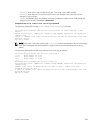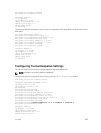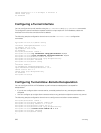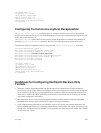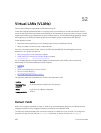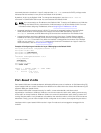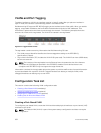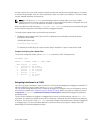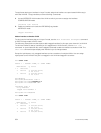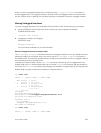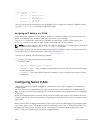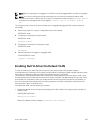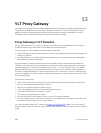
command places the interface in Layer 2 mode and the show vlan command in EXEC privilege mode
indicates that the interface is now part of the Default VLAN (VLAN 1).
By default, VLAN 1 is the Default VLAN. To change that designation, use the default vlan-id
command in CONFIGURATION mode. You cannot delete the Default VLAN.
NOTE: You cannot assign an IP address to the Default VLAN. To assign an IP address to a VLAN that
is currently the Default VLAN, create another VLAN and assign it to be the Default VLAN. For more
information about assigning IP addresses, refer to Assigning an IP Address to a VLAN.
• Untagged interfaces must be part of a VLAN. To remove an untagged interface from the Default
VLAN, create another VLAN and place the interface into that VLAN. Alternatively, use the no
switchport
command, and Dell Networking OS removes the interface from the Default VLAN.
• A tagged interface requires an additional step to remove it from Layer 2 mode. Because tagged
interfaces can belong to multiple VLANs, remove the tagged interface from all VLANs using the no
tagged interface command. Only after the interface is untagged and a member of the Default
VLAN can you use the
no switchport command to remove the interface from Layer 2 mode. For
more information, refer to VLANs and Port Tagging.
Example of Configuring an Interface for Layer 2 Belonging to the Default VLAN
Dell(conf)#interface tengigabitethernet 1/2/1
Dell(conf-if)#no shut
Dell(conf-if)#
switchport
Dell(conf-if)#show config
!
interface TenGigabitEthernet 1/2/1
no ip address
switchport
no shutdown
Dell(conf-if)#end
Dell#show vlan
Codes: * - Default VLAN, G - GVRP VLANs
NUM Status Q Ports
* 1 Active U Te 1/2/1
T Te 1/1/1
Port-Based VLANs
Port-based VLANs are a broadcast domain defined by different ports or interfaces. In Dell Networking OS,
a port-based VLAN can contain interfaces from different line cards within the chassis. Dell Networking OS
supports 4094 port-based VLANs.
Port-based VLANs offer increased security for traffic, conserve bandwidth, and allow switch
segmentation. Interfaces in different VLANs do not communicate with each other, adding some security
to the traffic on those interfaces. Different VLANs can communicate between each other by means of IP
routing. Because traffic is only broadcast or flooded to the interfaces within a VLAN, the VLAN conserves
bandwidth. Finally, you can have multiple VLANs configured on one switch, thus segmenting the device.
Interfaces within a port-based VLAN must be in Layer 2 mode and can be tagged or untagged in the
VLAN ID.
Virtual LANs (VLANs)
931



